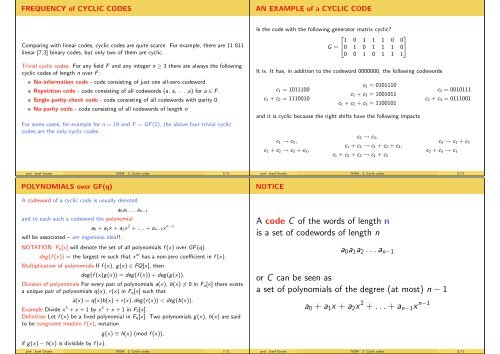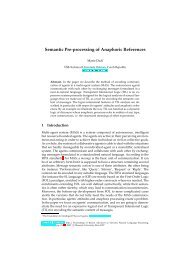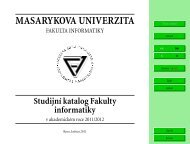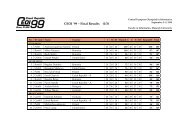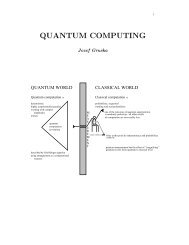2×2 handouts
2×2 handouts
2×2 handouts
Create successful ePaper yourself
Turn your PDF publications into a flip-book with our unique Google optimized e-Paper software.
FREQUENCY of CYCLIC CODES<br />
AN EXAMPLE of a CYCLIC CODE<br />
Comparing with linear codes, cyclic codes are quite scarce. For example, there are 11 811<br />
linear [7,3] binary codes, but only two of them are cyclic.<br />
Trivial cyclic codes. For any field F and any integer n ≥ 3 there are always the following<br />
cyclic codes of length n over F :<br />
No-information code - code consisting of just one all-zero codeword.<br />
Repetition code - code consisting of all codewords (a, a, . . . ,a) for a ∈ F .<br />
Single-parity-check code - code consisting of all codewords with parity 0.<br />
No-parity code - code consisting of all codewords of length n<br />
For some cases, for example for n = 19 and F = GF (2), the above four trivial cyclic<br />
codes are the only cyclic codes.<br />
Is the code with the following generator matrix cyclic?<br />
2<br />
1 0 1 1 1 0<br />
3<br />
0<br />
G = 40 1 0 1 1 1 05<br />
0 0 1 0 1 1 1<br />
It is. It has, in addition to the codeword 0000000, the following codewords<br />
c 1 = 1011100<br />
c 1 + c 2 = 1110010<br />
c 2 = 0101110<br />
c 1 + c 3 = 1001011<br />
c 1 + c 2 + c 3 = 1100101<br />
and it is cyclic because the right shifts have the following impacts<br />
c 1 → c 2 ,<br />
c 1 + c 2 → c 2 + c 3 ,<br />
c 2 → c 3 ,<br />
c 3 = 0010111<br />
c 2 + c 3 = 0111001<br />
c 3 → c 1 + c 3<br />
c 1 + c 3 → c 1 + c 2 + c 3 ,<br />
c 2 + c 3 → c 1<br />
c 1 + c 2 + c 3 → c 1 + c 2<br />
prof. Jozef Gruska IV054 3. Cyclic codes 5/71<br />
POLYNOMIALS over GF(q)<br />
prof. Jozef Gruska IV054 3. Cyclic codes 6/71<br />
NOTICE<br />
A codeword of a cyclic code is usually denoted<br />
a 0 a 1 . . . a n−1<br />
and to each such a codeword the polynomial<br />
will be associated – am ingenious idea!!.<br />
a 0 + a 1 x + a 2 x 2 + . . . + a n−1 x n−1<br />
NOTATION: F q [x] will denote the set of all polynomials f (x) over GF (q).<br />
deg(f (x)) = the largest m such that x m has a non-zero coefficient in f (x).<br />
Multiplication of polynomials If f (x), g(x) ∈ FQ[x], then<br />
deg(f (x)g(x)) = deg(f (x)) + deg(g(x)).<br />
Division of polynomials For every pair of polynomials a(x), b(x) ≠ 0 in F q [x] there exists<br />
a unique pair of polynomials q(x), r(x) in F q [x] such that<br />
a(x) = q(x)b(x) + r(x), deg(r(x)) < deg(b(x)).<br />
Example Divide x 3 + x + 1 by x 2 + x + 1 in F 2 [x].<br />
Definition Let f (x) be a fixed polynomial in F q [x]. Two polynomials g(x), h(x) are said<br />
to be congruent modulo f (x), notation<br />
if g(x) − h(x) is divisible by f (x).<br />
g(x) ≡ h(x) (mod f (x)),<br />
prof. Jozef Gruska IV054 3. Cyclic codes 7/71<br />
A code C of the words of length n<br />
is a set of codewords of length n<br />
a 0 a 1 a 2 . . . a n−1<br />
or C can be seen as<br />
a set of polynomials of the degree (at most) n − 1<br />
a 0 + a 1 x + a 2 x 2 + . . . + a n−1 x n−1<br />
prof. Jozef Gruska IV054 3. Cyclic codes 8/71


